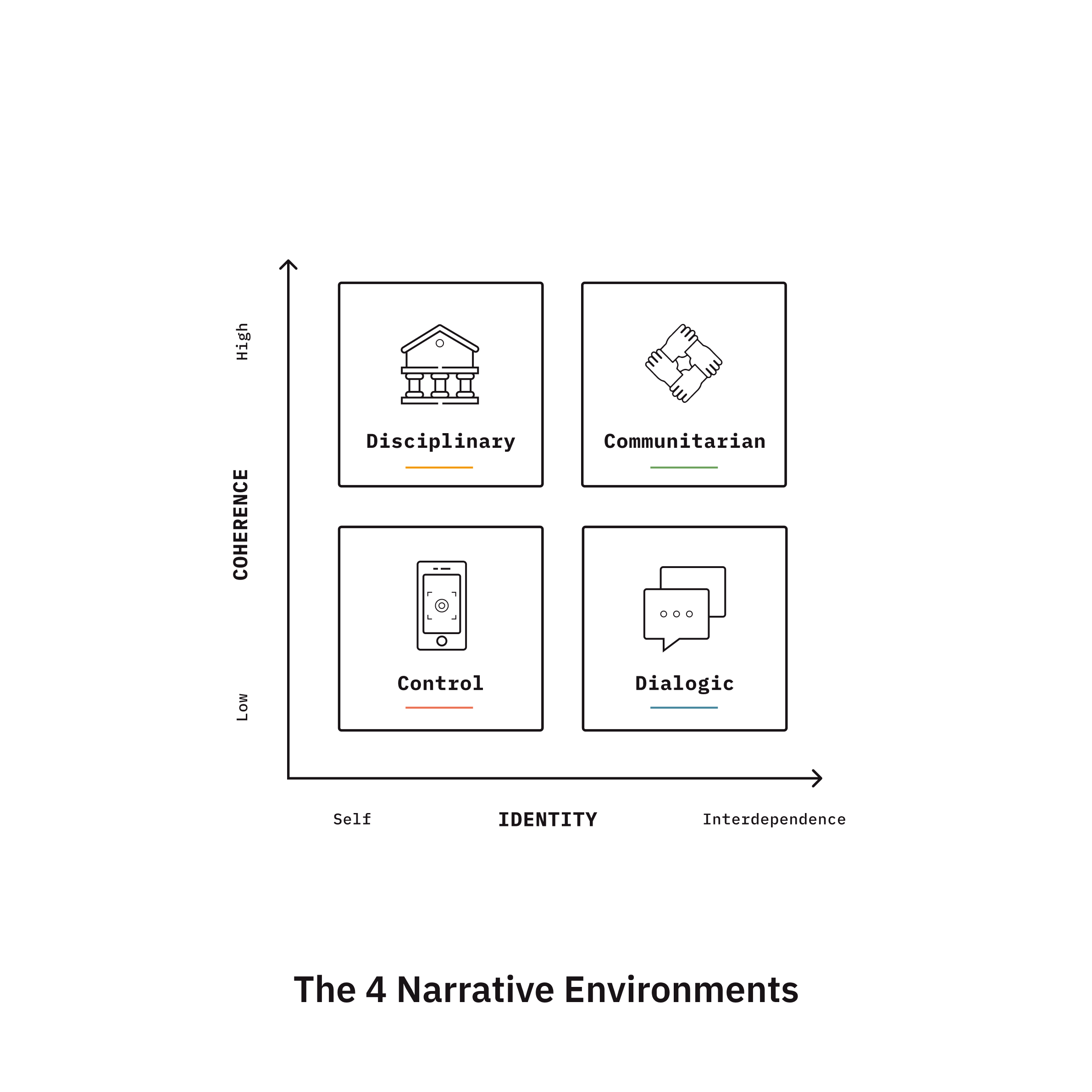Cultural Evolution
Greetings and welcome to our module on Cultural Evolution.
It is important to note that we are not talking about traditional Darwinian evolution, nor about evolution in terms of competition, but about the emergence of new forms of cooperation and coordination among humans. Our ultimate goal is to evolve the dominant cultures that create, sustain and perpetuate the Anthropocene, through narratives.
In this module we will learn what a narrative environment is and describe the different types of narrative environments that we have identified. This will help you understand our model for life-centric cultural evolution.
Narrative environments are cultural contexts where related narrative forms live. Just as some species live in certain environments, certain narrative forms only live in specific narrative environments. When we understand the predominant narrative environments that exist we can better understand cultural evolution.
The diagram below pulls together the elements of narratives you’ve learned about so far.
You will learn more about narrative communities in Step 3 – Identifying narrative communities.
We have identified four narrative environments which describe the predominant cultural contexts in our current era:
The Disciplinary narrative environment is a cultural context in which institutions gain power through the physical enclosure of life. Examples of narrative forms in this environment are the ideas of prison cells, factories, classrooms or industrial farms.
The Control narrative environment is a cultural context in which individuals are given the illusion of personal freedom and liberty. An example of narrative forms in this environment is the idea of electoral democracy, where you can only choose from a predetermined list of options.
The Dialogic narrative environment is a cultural context in which people strive to find shared values even though they have different views. Examples of narrative forms in this environment are the idea of open source or peer to peer online communities, or the idea of Truth and Reconciliation Commissions that invite dialogue around crises.
The Communitarian narrative environment is a cultural context in which a collective who hold similar views live and work together for a shared purpose. An example of this narrative form is the idea of any local resilient community such as a Community Land Trust (a democratic organization that owns and develops land for the benefit of the community).
These four narrative environments contain different assumptions about the relationship between self and other (identity) and the diversity of belief systems found within the environment (coherence).
They can be mapped onto this graph. The identity axis measures the extent to which self is prioritized in relationship to the other in the narrative environment. The coherence axis measures the extent to which a diversity of ways of knowing and being are excluded (high coherence) or included (low coherence) in the narrative environment.
This is important to analyze as we will see in the next part of this module, these environments are unsustainable.

As you can see, while “dialogic” and “communitarian” narrative environments have high levels of interdependence between self and other, the “disciplinary” and “control” narrative environments are very individualistic.
The “communitarian” narrative environment (which is interdependent) and the “disciplinary” narrative environment (which is individualistic) do not contain a diversity of beliefs (high coherence). While the “control” narrative environment (which is individualistic) and “dialogic” narrative environment (which is interdependent) do promote a diversity of beliefs (low coherence).
In sum, fragile societies (e.g. neoliberal societies) tend to sit within the disciplinary and control environments, whereas more resilient societies that value interdependence (e.g. Community Land Trusts) tend to sit within the communitarian and dialogic environments.
Importantly, all narrative environments are anthropocentric and are contributing to a breakdown of the systems that sustain life.
Woah, that was a lot! Let that sink in. Ciao.
Footnotes
- Cultural evolution refers to the idea that the development and transmission of symbolic thought, values, norms and ethical imperatives among humans shape their behavior and impact their evolutionary trajectory. Cultural evolution operates alongside genetic evolution, in which humans inherit not only genes (genotypes) but also cultural traits (symbotypes) that influence their behavior, and has led to the emergence of new forms of cooperation and coordination among humans. For Culture Hack Labs, cultural evolution involves guiding the evolutionary process of cultural change towards value systems that are in service of life – which is necessary for ours and our planet’s survival. This definition is inspired by David Sloan Wilson and Lynn Margulis: read more.
- Life-centric cultural evolution describes the change of culture over time towards one that is in the service of life in all of its forms – both human and more-than-human, seen and unseen, for example, animals, plants, fungi and rivers. A life-centric culture is post-anthropocentric (criticizing species hierarchy and decentring the human), and non-dualistic (no conception of separation that transcends the Enlightenment era system of meaning that relies on binary oppositions). Read more.
- Read more about our model of self and other in Module 1.